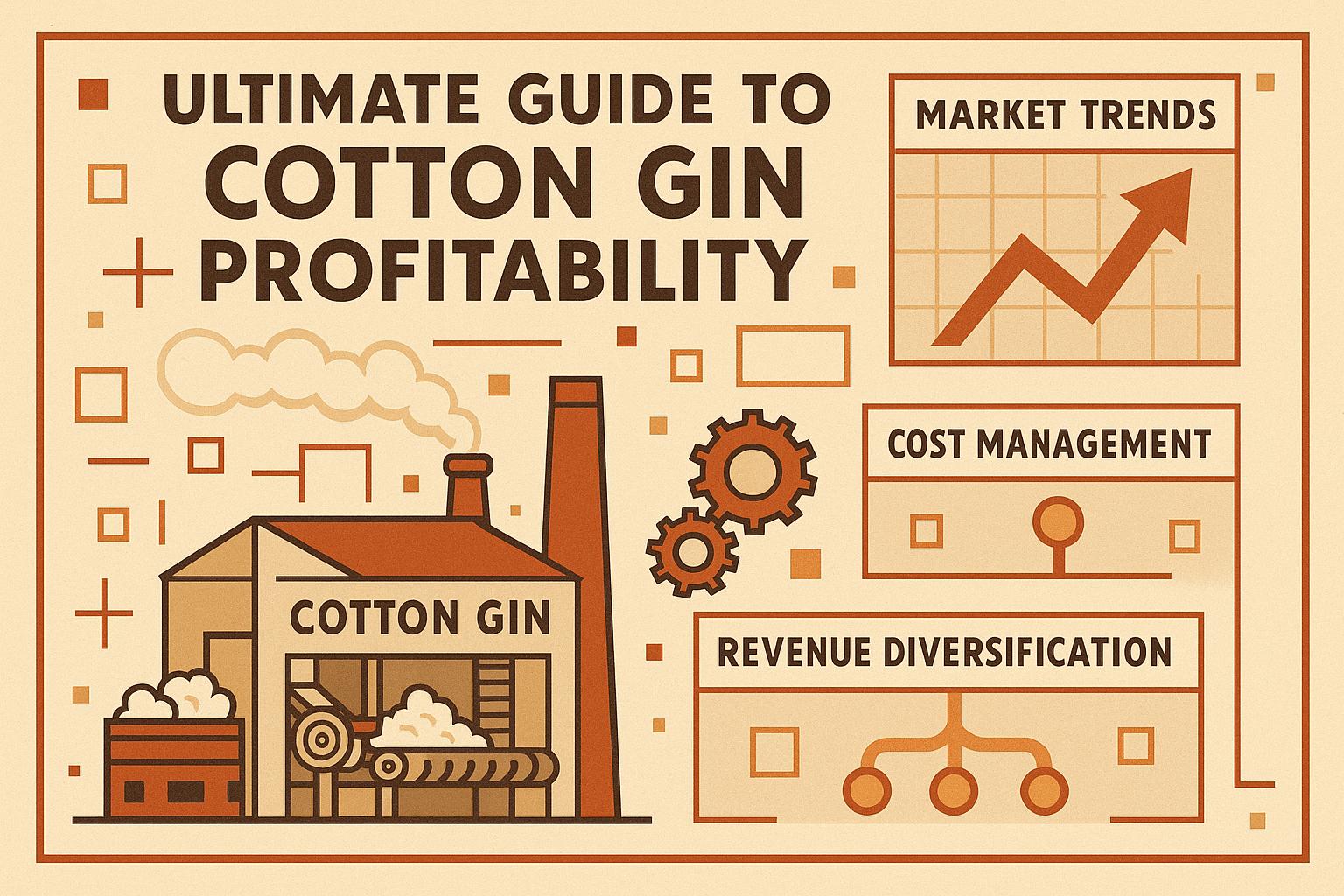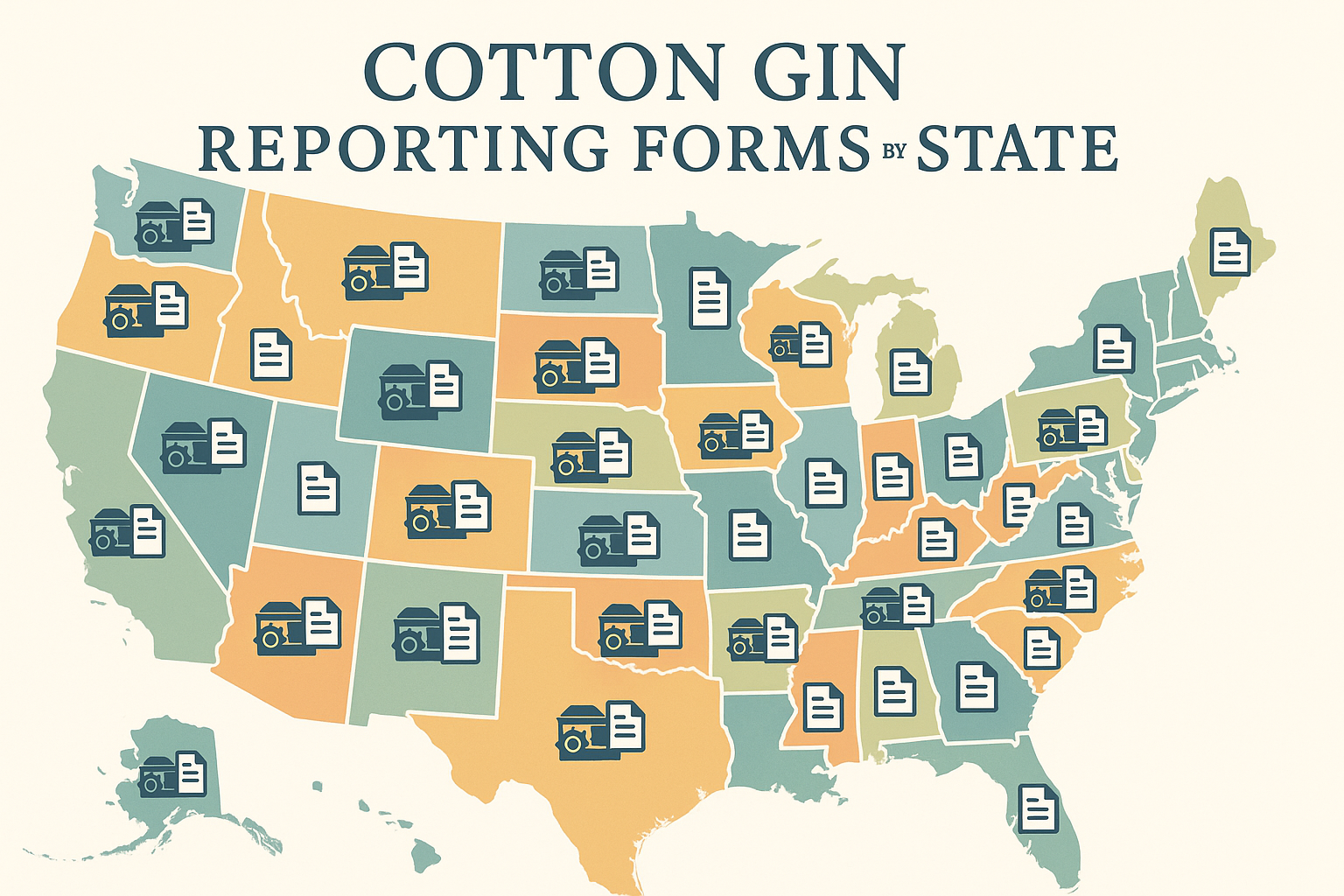Plastic contamination is a big problem in cotton processing. It reduces fiber quality, damages equipment, and lowers profits. Modern plastic detection systems help by automatically spotting and removing plastic during ginning. Here's what you need to know:
- How It Works: Advanced sensors (like RGB cameras or hyperspectral imaging) detect plastic, and systems like air jets or mechanical tools remove it immediately.
- Key Benefits:
- Improves cotton quality and market price.
- Reduces downtime caused by equipment jams.
- Protects U.S. cotton's reputation for being contamination-free.
- Challenges:
- Hard-to-detect plastics (e.g., clear or dark materials).
- High costs and maintenance needs.
- Environmental factors like dust and moisture.
Future advancements, such as AI-powered detection, portable units, and recycling integration, promise even better results. These systems are critical for cleaner, higher-quality cotton production.
The Ginning Process
Main Parts of Plastic Detection Systems
Modern plastic detection systems in cotton gins combine advanced sensors with automated removal tools to tackle contamination efficiently.
Detection Technology Types
These systems rely on different sensing technologies to spot plastic contaminants:
- Color-Based Detection: RGB cameras mounted on gin-stand feeder aprons identify colored plastic materials against the white cotton background.
Some cutting-edge systems are experimenting with hyperspectral imaging. This technology captures data across many wavelength bands, offering more detailed material analysis and improving detection accuracy.
Once contaminants are detected, automated removal processes are triggered immediately.
Plastic Removal Methods
After identifying plastic, automated systems like high-pressure air jets remove the contaminants with minimal disruption to the cotton flow. The USDA Agricultural Research Service (USDA-ARS) has developed specialized removal mechanisms that work seamlessly with advanced detection algorithms.
Air Knife Technology
- High-pressure air jets precisely target and remove contaminants.
- Ensures continuous cotton flow without interruptions.
Automated Mechanical Systems
In 2022, USDA-ARS collaborated with Texas A&M University to design an automated removal system tailored for module feeders. This system uses USDA-ARS detection algorithms to trigger actions, significantly reducing the need for manual labor and preventing plastic from entering the ginning process.
Control System Connection
The final component of these systems is the integrated control system, which works in tandem with detection and removal. Modern control systems offer:
- Real-Time Processing: Detection data is analyzed instantly and sent to the control system.
- Automated Responses: Immediate removal actions are triggered whenever contamination is detected.
- Data Logging: Systems record contamination events and removal performance for future analysis.
Strategic placement of detection systems at critical points in the process enhances efficiency:
| Detection Point | Purpose | Key Benefit |
|---|---|---|
| Module Feeder Entry | Early detection of large plastics | Prevents plastic from breaking apart |
| Dispersing Cylinders | Captures accumulated plastics | Protects equipment from damage |
| Gin Stand Apron | Final check before processing | Ensures high-quality cotton |
Advantages of Plastic Detection Systems
Modern plastic detection systems streamline operations and strengthen market competitiveness.
Better Cotton Quality and Price
These advanced systems play a crucial role in maintaining cotton quality by preventing plastic contamination. Clean, uncontaminated cotton consistently fetches higher prices, with buyers willing to pay a premium for contamination-free bales. Research from USDA-ARS highlights the financial benefits of delivering clean cotton.
"U.S. cotton has historically maintained a reputation for being contamination-free, which has allowed it to command premium prices in international markets", states a USDA-ARS study.
| Quality Impact | Financial Benefit |
|---|---|
| Premium Grade Classification | Higher price per pound |
| Contamination-Free Status | Access to premium markets |
| Consistent Quality | Builds long-term buyer relationships |
| Enhanced Fiber Integrity | Fewer quality-related claims |
These improvements not only boost financial returns but also ensure smoother operational workflows.
Less Processing Downtime
Plastic contamination can wreak havoc on processing equipment, causing frequent stoppages. Items like module wraps and plastic bags often jam machinery, leading to costly delays and manual clean-up efforts. Automated detection and removal systems, especially those integrated into module feeders, address these challenges by:
- Preventing equipment damage downstream
- Reducing the need for manual intervention
- Ensuring continuous processing flow
- Increasing overall throughput
By minimizing disruptions, these systems keep production lines running efficiently.
Clean Cotton Reputation
Consistent quality and reduced downtime help uphold the global reputation of U.S. cotton. As international textile manufacturers enforce stricter contamination standards, plastic detection technology ensures that U.S. cotton meets these demands. Machine-vision inspection systems demonstrate the industry's commitment to quality control, helping cotton producers maintain access to premium markets and sustain buyer trust.
This technology has become especially critical after the introduction of round module builders on harvesters, which introduced new contamination risks. By integrating efficiency, quality, and brand reliability, plastic detection systems are vital for preserving the U.S. cotton industry's standing in global markets.
Current System Limitations
Despite advancements in plastic detection systems for cotton gins, several hurdles still impact their effectiveness and practical use.
Hard-to-Detect Materials
One of the biggest challenges lies in identifying certain types of plastic contaminants. Plastics that are dark-colored or made from mixed materials are particularly tricky because their light reflectance properties closely resemble those of cotton fibers. According to a USDA-ARS study, while commercial cleaners are good at removing colored plastics, they struggle with clear or dark plastics, especially when used later in the ginning process.
Here’s how detection accuracy varies by plastic type:
| Plastic Type | Detection Rate | Primary Challenge |
|---|---|---|
| Colored Plastics | High | Minimal false positives |
| Dark/Black Plastics | Low–Medium | Resemble shadow patterns |
| Clear Plastics | Low | Issues with light transmission |
| Mixed-Material Plastics | Variable | Inconsistent optical signatures |
These limitations, combined with the high costs of detection systems, create significant barriers for widespread adoption.
System Costs and Upkeep
The financial demands of installing and maintaining detection systems can be steep, making it harder for smaller operations to adopt these technologies. Maintenance tasks include:
- Regular sensor calibration and alignment
- Cleaning or replacing camera lenses
- Performing software updates and troubleshooting
- Managing environmental controls to ensure optimal operation
The ongoing upkeep adds to the overall expense of these systems, further complicating their implementation.
Physical Operating Limits
In addition to detection difficulties and costs, several environmental and operational factors also limit system performance.
-
Environmental Interference
Dust and moisture can interfere with sensors, reducing their accuracy. These conditions may also cause plastic fragments to stick to cotton, complicating the cleaning process. -
Processing Speed Challenges
When cotton flows through the system at high densities, sensors can become overwhelmed, leading to reduced clarity and less effective detection. -
Installation Timing
According to USDA-ARS findings, detection systems installed late in the ginning process allow more plastic contaminants to slip through. Proper placement at multiple stages of the process is essential for better contamination control.
sbb-itb-0e617ca
What's Next in Plastic Detection
As the industry works to tackle the current challenges of plastic contamination in cotton gins, new technologies are emerging that could revolutionize detection methods. These advancements aim to not only improve accuracy but also streamline operations, ensuring better outcomes for cotton processing.
AI Detection Advancements
Artificial intelligence is stepping up as a game-changer for plastic detection in cotton gins. Sophisticated algorithms are being developed to identify contaminants that were previously difficult to detect. This means better accuracy and faster processing, which could lead to more efficient monitoring systems that adapt to the unique demands of ginning operations.
Portable Detection Units
The introduction of mobile detection units is adding a new level of flexibility to the ginning process. These portable sensors can be deployed at different stages, allowing for real-time monitoring and quicker responses to contamination issues. They work alongside fixed detection systems, offering a more adaptable approach to contamination control.
Combining Detection with Recovery
Looking ahead, future systems may combine plastic detection with recycling capabilities. These integrated setups could help reduce plastic waste while maintaining the quality of cotton. This dual-purpose approach aligns with broader efforts to make the industry more environmentally responsible, presenting a win-win for both cotton producers and sustainability goals. By linking detection with recovery, cotton gins could achieve higher standards of quality and contribute to reducing environmental impact.
Conclusion
Plastic detection systems have become indispensable tools in cotton gins, playing a critical role in preserving cotton quality and minimizing contamination. They act as the first line of defense against plastic pollutants during processing, ensuring smoother operations and better outcomes.
By leveraging advanced detection technologies, these systems help maintain cotton purity, reduce plastic waste, and improve both the market value of cotton and its environmental impact. For cotton gins across the United States, investing in such systems is not just practical - it’s a smart move toward higher standards and cleaner production.
Looking ahead, ongoing improvements promise even greater efficiency and effectiveness. The adoption of AI-powered detection methods and portable monitoring units is already enhancing contamination control, pushing the industry toward more comprehensive solutions. These advancements reflect a strong commitment to quality and environmental responsibility, benefiting both producers and the broader industry.
As these systems continue to evolve and become more widely available, they remain essential to upholding the reputation of American cotton. Their development ensures that cotton production stays aligned with the highest standards of quality and sustainability.
FAQs
How do plastic detection systems in cotton gins identify plastics, including clear or dark materials, without confusing them with cotton fibers?
Plastic Detection Systems in Cotton Gins
Plastic detection systems in cotton gins rely on cutting-edge tools like optical sensors, infrared imaging, and machine learning algorithms to separate plastics from cotton fibers. These technologies are built to pick up on subtle material differences, such as how light reflects off the surface, thermal patterns, or even texture. This level of precision is crucial for identifying tricky plastics, including clear or dark materials that are often harder to spot.
By pinpointing and removing plastics during the ginning process, these systems play a key role in preserving cotton quality, minimizing contamination, and boosting production efficiency.
What are the costs and maintenance needs for using plastic detection systems in smaller cotton gins?
The expenses and upkeep involved in setting up plastic detection systems in smaller cotton gins depend on several factors, such as the gin's size, the type of system selected, and its specific features. Upfront costs typically include buying the equipment, paying for installation, and possibly integrating it with existing software. Additionally, smaller gins should plan for periodic updates or calibrations to keep the system running at its best.
On the maintenance side, these systems usually need regular inspections to ensure the sensors and detection components are functioning correctly. Routine cleaning and occasional part replacements might also be required, influenced by how often the system is used and the surrounding environment. While the investment might seem significant, a dependable plastic detection system can greatly minimize contamination risks, enhancing cotton quality and ensuring smoother operations in the long run.
How could AI technology and portable systems enhance plastic detection in cotton gins in the future?
Future developments in AI-driven detection systems and portable devices could bring major improvements to how plastic contaminants are identified in cotton gins. With AI, detection could become far more precise, cutting down on false positives and ensuring cleaner, higher-quality cotton. Meanwhile, portable systems could make it possible to spot and remove contaminants on-site and at various stages of production.
Together, these advancements could simplify operations, reduce delays, and enhance quality control across cotton ginning facilities.


